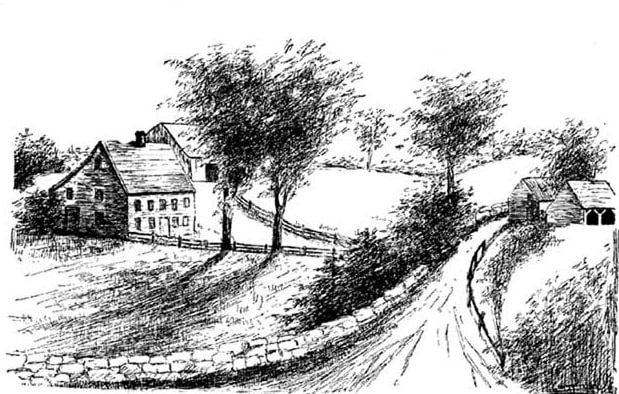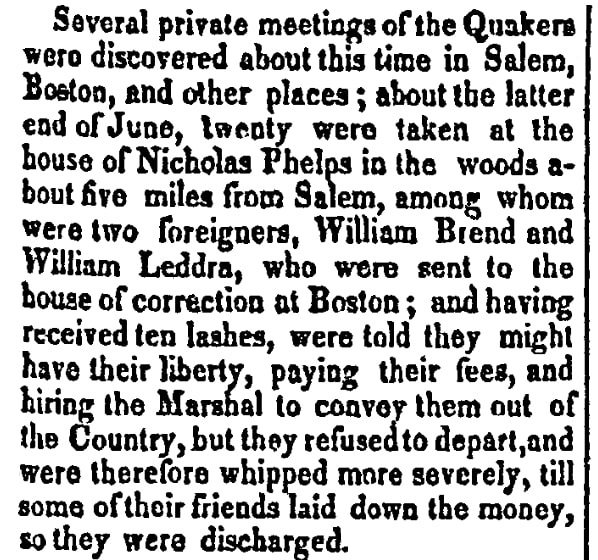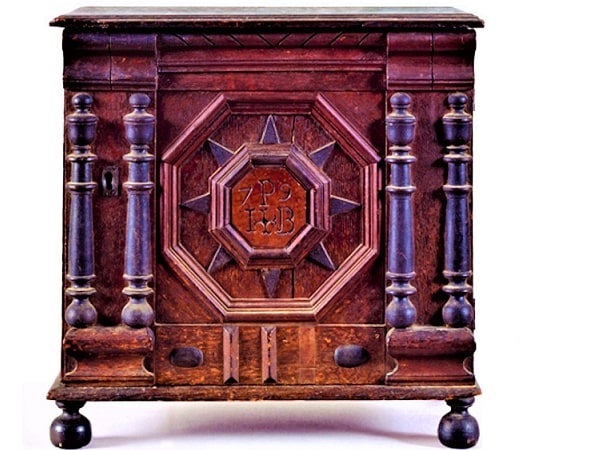Introduction: In this article, Melissa Davenport Berry continues her story about the persecution of Quakers by the 17th century Puritan authorities, focusing on the Phelps and Pope families. Melissa is a genealogist who has a blog, AnceStory Archives, and a Facebook group, New England Family Genealogy and History.
“There is a people not so rigid as others are at Boston, and there are great desires among them after the Truth. Some there are, as I hear, convinced, who meet in silence at a place called Salem.”
–Henry Fell
The passage above was written by Quaker minister Henry Fell in the Barbados to his wife Margaret, dated 19 December 1656, and cited in James Bowden’s The History of the Society of Friends in America (pp. 54-55). This is the earliest mention of Quakerism in Salem, Massachusetts.
In today’s article I cover the list of attendees at two Quaker meetings held in Salem that were raided by the authorities in 1658. Such meetings were illegal, and the magistrates were enforcing strict laws. (See: Persecuted Quakers in Colonial America.)

The first Quaker meeting was at the home of Lawrence and Cassandra Southwick on June 5, and the second meeting was at the home of Nicholas and Hannah Phelps on June 27.
In 1720, Daniel Neal published The History of New-England, and the New-Hampshire Republican printed extracts from his book, including this report of the Quaker meetings.

Here is a list of the people apprehended for attending these meetings, as cited in the “Records and Files of the Quarterly Courts of Essex County, Volume 2”:
- Nicholas Phelps and wife Hannah
- Lawrence and Cassandra Southwick and children John, Josiah, Daniel, and Provided
- Samuel Shattuck and wife [Hannah]
- John Small
- Anthony Needham and wife [Anne Potter/Porter]
- Edward Wharton
- Samuel Gaskill [husband of Provided Southwick]
- Wife of Henry Trask [Mary Southwick]
- Robert Adams of Newbury
- John Hill and wife Lydia [Buffum]
- Thomas Brackett
- Wife of John Smith [Margaret]
- Daughter of Robert Buffum [Deborah Wilson; Margaret]
- Wife of George Gardiner [Elizabeth Freestone]
- Wife of Robert Buffum [Thomasine] and son Joshua
- Joseph Pope and wife Gertrude [Shattuck]
- Wife of Isaac Page [Damaris Shattuck]
The whole skinny on the legal hearings can be found online at the University of Virginia “Records and Files of the Quarterly Courts of Essex County, Volume 2.”
The historical significance of these persons in Salem is vast and should not be forgotten. For example, the Daily Advocate noted that both the Quaker persecutions and the 1692 Salem witch trials are associated with a rare cabinet made in Salem by cabinetmaker James Symonds, dated 1679, now in the collection of the Peabody Essex Museum (PEM).
The chest, or “valuables cabinet,” was gifted to Joseph Pope – son of Joseph and Gertrude (Shattuck) Pope, and his wife Bathsheba Folger – daughter of Peter Folger and aunt to Benjamin Franklin.
Joseph Pope and his wife Gertrude are listed in the court files for attending Quaker meetings, and purchased their home from Nicholas Phelps in 1666 – the house where the Quaker meeting was held in 1658. Joseph (senior) willed the home to his son Joseph, owner of the valuables cabinet.
The PEM acquired the antique chest in 2000 from Christie’s Auction House and paid $2,422, 500 for it. It is now on view in the Barbara Weld Putnam Gallery.
As noted in the Daily Advocate article:
“The Popes were also related to the Southwicks, who were among the early Quakers who were persecuted, punished and driven out of Massachusetts by the Pilgrims.”
The cabinetmaker Symonds was related as well. His sister Ruth married a Southwick.
In fact, Symonds made similar cabinets for many Quaker relations affiliated through marriages, as cited in Martha H. Willoughby’s “Patronage in Early Salem: The Symonds Shops and Their Customers.” Among the names noted: Buffington, Southwick, Trask, Buffum, and Osborne.
John Hays of Christie’s called the Pope cabinet:
“a better window into the 17th century than anything I’ve ever handled. It brings together the cabinetmakers, first-generation immigrants, the Salem witch trials, and the founders of our nation.”
Note: Just as an online collection of newspapers, such as GenealogyBank’s Historical Newspaper Archives, helped tell the stories of the persecuted Quakers, they can tell you stories about your ancestors that can’t be found anywhere else. Come look today and see what you can discover!
Upcoming: more about the Quakers in 17th century America.
Related Articles:
